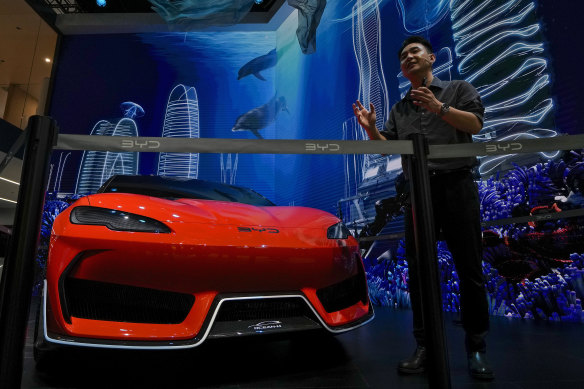
That’s unlikely, given that subsidisation of strategic industries like EVs or solar panels is at the core of China’s economic model, its industrial policies and Xi Jinping’s economic and geopolitical ambitions.
“New energy vehicles” were identified as a strategic sector in China’s 2015 five-year plan for the country’s economic future under the Made in China 2025 strategy blueprint that alerted the rest of the world to the country’s aspiration of dominating key global sectors in the 21st-century global economy.

European Commission President Ursula von der Leyen says she is keen to negotiate with China.Credit: AP
While any significant withdrawal of the massive support Beijing and local governments have provided to the EV sector appears improbable, China could take steps to reduce the current massive overproduction occurring within its EV and solar sectors, where weaker domestic demand has resulted in a rising tide of exports.
It could also offer wider trade concessions. The EU had a €291 billion ($470 billion) trade deficit with China last year. China could offer Europe greater market access in exchange for a gentler treatment of its EV manufacturers.
As it stands, China has been waving the carrot of greater investment and the stick of retaliatory trade measures at the EU.
While a number of China’s EV and battery makers have foreshadowed plans to build plants within Europe, China has also threatened to slap its own tariffs on Europe’s brandy, agricultural products, luxury car and aviation industries.
Loading
It has also pointed to a European dilemma. The EU is determined to drive down its carbon emissions, and a key plank of its strategy is to end sales of new combustion engine vehicles by 2035. Without cheap Chinese EVs, that’s probably not possible.
The EU has some leverage of its own. The US has imposed a tariff on Chinese EVs of more than 100 per cent (not that many have been sold in the US) and has been broadening the range of Chinese goods subject to tariffs. If Donald Trump regains the White House, he has promised to impose a tariff of 60 per cent on all Chinese imports.
Increasingly shut out of the US, China needs the European markets for its exports if the manufacturing-led strategy it switched to after its property sector melted down in 2021 is to be effective and its economy is to grow at respectable rates. It can’t afford a full-scale trade war with Europe.
The two economies, including the EV sector, are already highly enmeshed. The strongest opposition to the EV tariffs within Europe has come from European carmakers that have a major presence within China’s domestic industry, most particularly the German auto industry.
They are concerned that their exports to China will face higher duties, while their imports into Europe from their Chinese plants and joint ventures will also be punished.

BYD has a massive cost advantage over its peers and generates profit margins in Europe that are up to 10 times those it achieves within China.Credit: AP
The EU, however, is determined to ensure that it doesn’t experience a second China shock. In the early 2000s, a flood of cheap Chinese exports decimated the manufacturing bases of advanced economies. More recently, Beijing’s targeting of green technologies has effectively wiped out the rest of the world’s solar-cell manufacturing capabilities.
A deal could be done that enables China to maintain large volumes of EV imports into Europe and aids Europe’s pursuit of a low-carbon economy, but it will, from the EU perspective, need to be one that leaves it with a viable and large domestic auto industry and, more broadly, a green technology industry of its own.
As it happens, even with the increased tariffs, some Chinese manufacturers are unlikely to be priced out of the European markets.
China can’t afford a full-scale trade war with Europe.
BYD, for instance, co-operated with the EU and has been levied with an additional tariff rate of 17.4 per cent, taking its total tariff to 27.4 per cent. However, it currently has a massive cost advantage over its peers and generates profit margins in Europe that are up to 10 times those it achieves within China.
It has been estimated that it would take a tariff rate of more than 50 per cent to deter BYD and most of its peers from selling into Europe.
With the higher duties they now face, it might be less profitable for most of them to export to Europe than it was, but it would still be significantly more profitable than selling into an oversupplied domestic market, where margins have plummeted even as investment in the sector has soared.
Loading
It also makes sense for BYD and some of its peers to do more manufacturing within Europe, despite the higher costs, exploiting China’s dominance of the EV raw materials supply chain and the technological advantages they have gained from scale manufacturing amid intense competition in a market with an overabundance of manufacturers (attracted by the subsidies) in China.
It gets them inside the EU’s tariff wall, wins political protection from the economies in which it invests, diversifies their businesses away from an economy in which there is weak domestic demand, and might provide a backdoor entry into markets with which the EU has strong trade relationships.
For economies like Australia’s, of course, where there is no domestic auto industry to protect, fewer Chinese EV exports to Europe could mean more cheap Chinese-manufactured EVs flowing into this market, which would be good for consumers and emissions.









 Add Category
Add Category